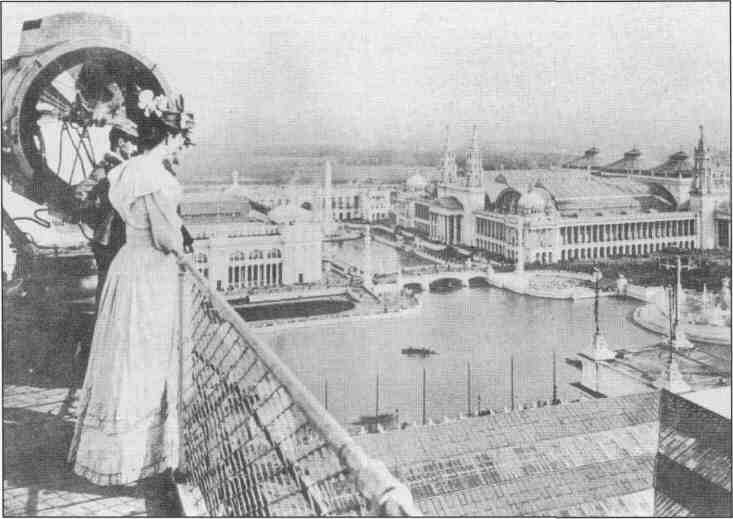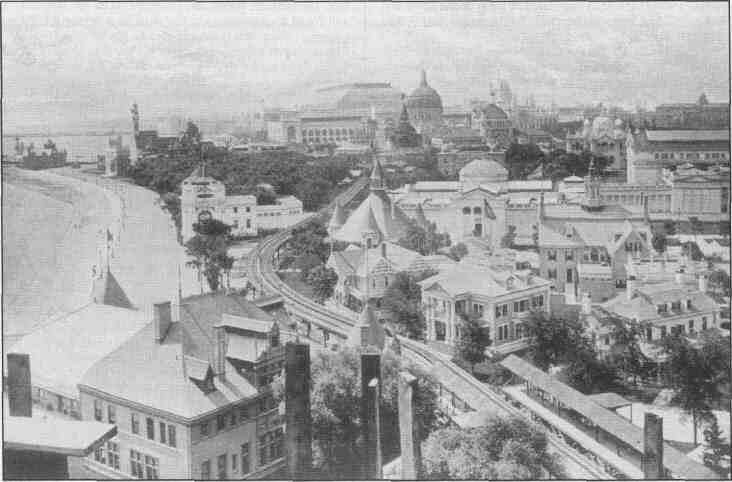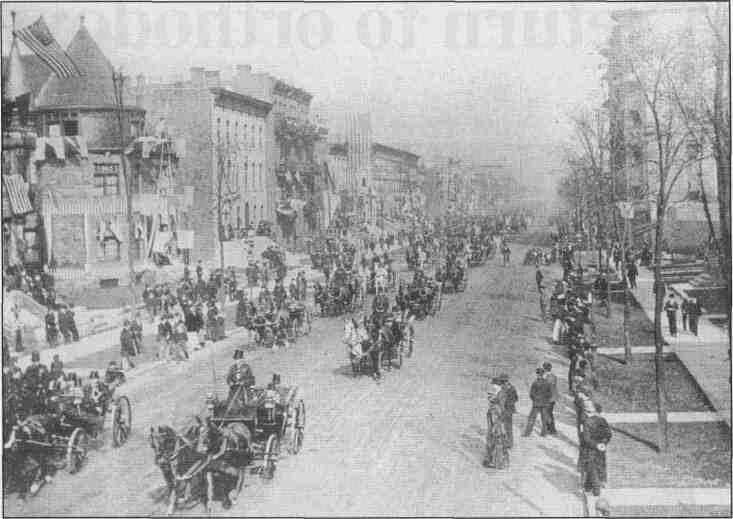 |
Home | Search | Browse | About IPO | Staff | Links |
 |
Home | Search | Browse | About IPO | Staff | Links |
|
A review essay by JAMES KROHE JR.

From the collection of the Illinois State Historical Library, courtesy Chicago Historical Society In the six months it was open, the 1893 World's Columbian Exposition attracted 27, 539, 000 visitors almost half the total number of people living in the United States. Overnight, Chicago became the best known city in the world. By reminding millions of the beauties of the classic forms of architecture, the Exposition started a trend that was to last for a generation. The view includes the Court of Honor, seen here from the top of the Manufacturers Building. Chicago resurrection Modern urbanism was born in Chicago. Today, we need a bold new prescription for bringing a great city back to life November 1995/ Illinois Issues/21 In 1953, would-be reformers Arthur Hillman and Robert Casey wrote a book they titled Tomorrow's Chicago, in which (as reformers tend to do) they predicted the doom that would befall the city if their advice were ignored. "Chicago can, of course, be made into a pleasant, comfortable town," they asserted. "Or ... it can die." In fact, Chicago has died many times since 1953. Chicago the meat-packing town is dead. Chicago the union town is dead. Chicago the City that Works is dead. What isn't dead is the hope that Chicago can, in spite of the evidence, again be made into a pleasant, comfortable town. Doing that, however, will test the resolve of even a Chicago reformer. Illinois' largest city (we speak now of the corporate city of Chicago, not the eponymous urban agglomeration it spawned) stands today shriveled and fearful, its corporate cloutmeisters distracted or indifferent, its own voters disenfranchised by political changes at the Statehouse. Its white people are too old, its minorities too young and too poor, its jobs too few. Throughout the 1980s the city suffered a net annual loss of 18, 000 whites. White flight from Chicago has been well noted. Socially, the loss of 8, 000 mainly middle-class blacks each year hurts just as much; combined with structural economic changes that have shriveled the black working class, the out-migration has left several neighborhoods bereft of any social infrastructure apart from gangs and welfare. It is not that Chicago is corrupt, or declasse. In the opinion of our urban seers, its fate is a function of its form. The wealth of the next century will not be produced, they say, in the cities of the last one. One doesn't need a crystal ball to predict Chicago's future, only a calculator. Naperville was the 10th fastest-growing city in the country between 1990 and 1994 (population up 17.9 percent, to 101, 163) while Chicago's population dropped 1.9 percent during the same period, to 2, 731, 743 just about exactly 25 percent fewer people than in 1950. At present rates of population loss, in fact. Mayor Daley VI will have to vote himself into office. But even as it shrinks in size and influence, Chicago seems to expand in horror. Chicago's social pathologies connect synergistically; in the sweltering summer of 1995, hundreds of mainly old people died, locked in unair-conditioned rooms because they were too afraid to open the door or even a window for fear of being robbed. What should we do with a city like that? James "Pate" Philip, the Senate president from suburban Wood Dale, represents a parochial point of view; the Pate-ian school of urbanism would leave the city to rot. This is satisfying as sport, but unimaginative as policy. The thing to do is not look at Chicago in the light of old enmities, but of new possibilities. After all, as critic Witold Rybczynski recalls in his new book. City Life, that toddlin' town was the place where 20th-century urbanism got its start. The skyscraper and the commercial downtown, to mention just two innovations, were invented or perfected in Chicago. Arguably even the genesis of the suburban mall is the White City of the World Columbian Exposition of 1893. Alas, it's been a long time since urbanists looked to Chicago for what's new. Corporate downsizing and the rise of suburban "edge cities" threaten to render the skyscraper and the centralized commercial downtown as outmoded as the stockyards. Daley the Younger gets quoted a lot on city administration, but the only thing interesting about what Daley is saying about city management is that it is a Daley saying it; his paeans to privatization and efficiency make him sound more like a Wheaton city manager than the scion of a liberal Democrat big-city mayor. Chicago's status as an urban laboratory may be divined from the decision of the reformist Civic Federation to hire William Hudnut as its president, in the hope that the man who used to be mayor of Indianapolis would have something to teach Chicago. Depopulation and the abandonment by industry has left Chicago much too small for its britches
Elbow room Rybczynski's point is polemical, meant to illustrate the still- strange notion that the problem with our older cities is that they don't have enough people in them. Chicago is already suburban in density if not in form. It ranks 70th in population density (measured in people per square mile) among the world's 75 most populous cities; even Paris has 2.5 times more people per mile than Chicago does. In fact, when it comes to paying for expensive services like the CTA, Chicago isn't nearly crowded enough. Alas, a City Hall that can't figure out how to recycle newspapers is not likely to get it right when it tries to recycle neighborhoods. This sort of thing has been tried before in Chicago, beginning with slum clearance in the 1930s and continuing with urban renewal in the 1950s and '60s, with depressing 22 /November 1995 / Illinois Issues 
Photograph courtesy of Illinois State Historical Library The skyscraper and the commercial downtown, to mention two innovations, were invented or perfected in Chicago. Arguably even the genesis of the suburban mall is the White City of the World Columbian Exposition of 1893. But it has been a long time since urbanists looked to Chicago for anything new. Corporate downsizing and new suburban "edge cities" threaten to render skyscrapers and the centralized downtown as outmoded as the old stockyards. results. True, conventional urban renewal failed in part because it tore down the wrong neighborhoods on the silly assumption that mere poverty rendered a neighborhood unlivable as well as unlovely. And yes, Chicago's most derelict districts these days are not merely poor socially, physically and economically, they scarcely exist. But it isn't as easy to throw poor people out of their houses as it used to be. Let us assume nonetheless that large tracts of once-built land could be assembled for redevelopment. Rather than attempt another version of urban renewal, which is known to not work, why not try a little urban re-engineering? Why not turn Chicago not only into a post-industrial city, but a post- urban city? Instead of social divisions, why not subdivisions? Why not put the "lawn" back in North Lawndale?
Front yards No suburban amenity (save schools where raising her hand at the wrong moment gets a kid chided by her teacher, not shot by her gang rivals) is more prized than a single-family house with a yard. The housing forms familiar from the city the row house, the tenement, the two- and three-flat were creations of speculative land economics, not consumer choice. Once the car and the FHA gave them a choice, the taxpaying, child-rearing middle class chose a split-level ranch with a two- car garage every time, even if it meant exile in Park Ridge. The present Daley Administration is well aware that decent affordable housing is the key to the economic revival of the city. (Hey, he moved to a better neighborhood himself, a kind of suburb-in-a-box called Central Station.) In September officials proposed making more than $75 million available in mortgage and down-payment assistance to middle-class home- November 1995/Illinois Issues/23 owners willing to build in impoverished areas on the South and West sides. And jobs will eventually follow people, just as they did to the suburbs. Market forces are transforming Chicago into another Carol Stream anyway. The suburbs have replaced the city as society's model for the good life, just as the city took over from the small town as the locus of American life in the last century. The intrusion of suburban-style strip malls into Chicago neighborhoods like Lakeview may offend the city lover's sense of aesthetic coherence and human scale, but they're making money. In New York, City Hall wants to open that city's underused manufacturing areas to suburban-style discount retailers and warehouse stores. Yes, you can get whatever you want at Wal-Mart for cheap even an urban renewal strategy.
Reinventing government A system of tax-sharing across borders administered by some new regional entity set up for the purpose might satisfy the demands of both fiscal equity and self-determination. Go- getting towns like Indianapolis, Minneapolis and Columbus, Ohio, do that in different ways; local models already exist from suburban pollution control or traffic planning. The re-engineering of Chicago may make sense to planners, but then planners don't have to run for office. Lynch himself noted that U.S. political and administrative systems have no effective control at the level of the metropolitan region, in part because people feel no sense of community that might give political legitimacy to such a system. Besides, the failures of both efficiency and equity in Chicagoland are less often failures of structure than of political will. Decades ago several million Illinoisans, organized in separate civic entities of disparate wealth and demographic traits, joined together to assess property and distribute tax revenues in the form of services on a regional basis. Yes, you guessed it the city of Chicago, most of whose neighborhoods such as Ravenswood and Hyde Park were independent towns and villages before they were annexed.
Reinventing Chicago The essence of suburban life is not architecture, after all: it is control. Democracy in the United States means the freedom to settle with people pretty much like ourselves and form governments whose main purpose is excluding people who aren't. Survey after survey has suggested that most Americans prefer to live in a political community small enough that residents feel they can influence ideally, a small town of between 20,000 to 40, 000. Affluence and the car have given a majority of Americans the chance to live that dream in the postwar suburb. Most of the radical new reforms in social service provision in big cities aim to give city people the political control over education, public safety, taxes and public investment that suburbanites already cherish. In Chicago, steps were taken long ago to disassemble the clanky apparatus of centralized political and administrative control by, for example, allowing the local election of public school councils. The feds have sniffed the new trend in the air too; policies for the Clintonite "empowerment zone" on the West Side are to be set by neighborhoods, not bureaucrats.
A short urban reader ...
Other more recent works worth noting on urbanism
and on the history and development of Chicago:
-Nature's Metropolis: Chicago and the Great West
by William Cronon. It was published in 1991 by W.W.
Norton & Co. Chicago: A Historical Guide to the
Neighborhoods, The Loop and South Side by Glen Holt
and Dominic Pacyga. It was published in 1979 by the
Chicago Historical Society. The Death and Life of
Great American Cities by Jane Jacobs. First published in
1961, it was issued in paperback by Vintage in 1992.
See also classic works by Lewis Mumford and
Frederick Law Olmsted. Mumford's The Culture of
Cities was published by Harcourt, Brace in 1938. The
City in History: Its Origins, Its Transformations, and
Its Prospects was published by Harcourt, Brace & World
in 1961. Civilizing American Cities: A Selection of
Frederick Law Olmsted's Writings on City Landscape
was edited by S.B. Sutton and published by MIT Press in
1971.
Peggy Boyer Long 24 / November 1995 / Illinois Issues  Photograph courtesy of Illinois State Historical Library Historian Frank A. Cassell notes that Chicago's "growing wealth, its restless energy, and the drive of its businessmen to achieve cultural respectability and additional profits were important factors in the exposition's history." This picture of the exposition parade was taken on Dedication Day on May 1, 1893. The Chicago neighborhood of fond memory shares many traits with the suburban enclave. Not least of these is scale; the average population of Chicago's 77 official "neighborhoods" is 35, 000, nicely within the range of our ideal political community. They also are largely self-contained in terms of class. They even have a tradition of self-defensive exclusionary local control; most of the energy expended in self-government in Chicago these days seems to go toward persuading those in power to keep their scattered-site housing or group homes or landfills out of our neighborhood. In America, suburbanites are born, not made. The neighborhoods even have a political infrastructure in place with the existing ward system, including in most wards an alderman who wants to be a mayor. What the poets of city form describe as "extensive multinucleate cities of low density" seems the natural form of the post-war U.S. megalopolis. Creating one out of a struggling compact nucleated high-density 19th-century city would allow Chicago to join the former Soviet Union, the Balkans and Quebec in the march toward a proudly self-determined 21st century. The first Chicago made itself up as it went along in response to new technologies and new industries, surprising the world not just as a new city but as a new kind of city. Is it loony to think it might do it again, by taking a battered 19th-century American industrial city and reinventing it as a 21st century one? No loonier perhaps than trying to turn Chicago into Paris, the way Daniel Burnham did with his Plan of Chicago in the 1900s. Or trying to simultaneously govern the Gold Coast and Woodlawn through the agency of Chicago aldermen. James Krohe Jr. is a contributing editor of Illinois Issues. November 1995/Illinois Issues/25
|